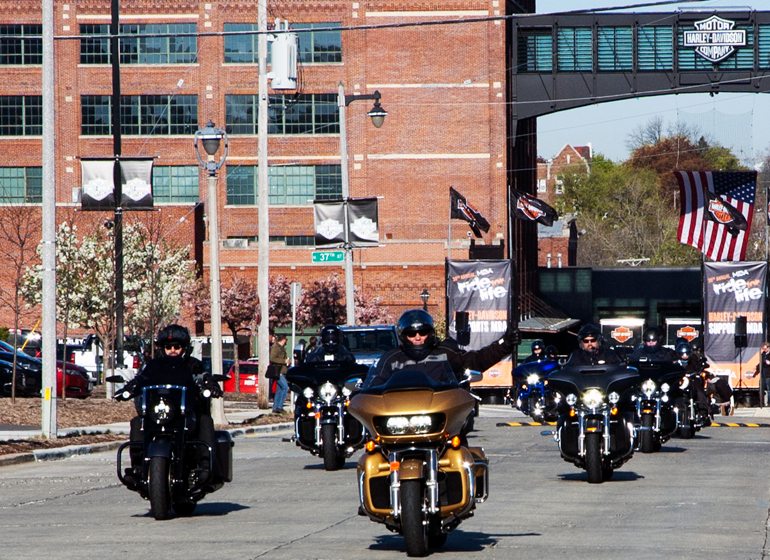Milwaukee-based Harley-Davidson Inc. plans to build the majority of its motorcycles destined for the European Union at its facility in Thailand, a decision intended to help the company avoid additional tariff costs.

Retaliatory tariffs by the EU and China, along with those the Trump administration has put on Chinese goods cost Harley $23.7 million in 2018 and an estimated $100 million to $120 million this year, according to company executives. Those rising costs, along with additional spending for recalls, restructuring and raw materials, nearly wiped out all of the company’s fourth quarter profits.
Harley had previously said it would move production of EU motorcycles out of the United States. The European Union last year increased tariffs on U.S. made motorcycles from 6 to 31 percent in response to President Donald Trump raising tariffs on European steel and aluminum.
The increased motorcycle tariffs would add about $2,200 to the price of a bike and Harley said it could not afford to pass the cost on to consumers or dealers.
Harley’s decision to move EU production overseas drew Trump’s ire last year with the president lashing out at the company on Twitter and in remarks at Foxconn’s groundbreaking in Mount Pleasant. Trump also said he was working with Harley’s competitors at one point.
Despite the presidential attention, Harley pressed ahead with its plans but had not previously said where the bikes would be produced. In addition to the Thailand facility, Harley has plants in Brazil and India that build motorcycles to avoid tariffs in those markets.
John Olin, chief financial officer of Harley-Davidson, said Tuesday on the company’s earnings call that the company plans to ship the majority of motorcycles for the EU, China and other southeast Asian markets from the Thai facility by the end of the year.
The facility, announced in 2017 and completed in the third quarter of 2018, was originally intended to supply China and southeast Asia. Harley says it is investing $15 million this year to have the capacity to serve the EU as well.
“Given the fact we’re now looking to supply additional markets from Thailand, we’re expanding the plant,” Olin said.
Before the capacity to ship from Thailand is in place, Harley says it is expecting an addition $100 million to $120 million in tariff costs this year. In 2018, tariffs cost Harley an additional $23.7 million.
The company’s tariff figures do not include increased raw material costs driven by tariffs on steel and aluminum. Raw material costs increased $17.7 million from 2017 to 2018.
Also adding to Harley’s increased costs last year were two recalls the company recorded charges for in the fourth quarter. One charge was for $35 million for clutch issues on certain Touring and Softail models. The second was a $20 million charge for a previously unannounced recall on Harley’s Street models.
Harley is recalling 43,908 model year 2016 to 2019 Street motorcycles because of an issue with brake calipers from a third-party supplier, according to Harley spokeswoman Pat Sweeney.
Around 13,000 of those motorcycles were sold in the U.S. Sweeney said corrosion issues with the caliper can lead to increased brake drag. Motorcycles used where road salt is common or in coastal areas are particularly at risk.
She added that Harley is not shipping any Street motorcycles until it has repair parts available.
All of the extra costs added up for Harley-Davidson in the fourth quarter. The company reported net income of $495,000, down from $8.3 million last year. Motorcycle related revenue was down and gross profit margins declined from 30.6 percent in 2017 to 27.6 percent in 2018. Selling, administrative and engineering expenses were up more than $18 million from 2017 and the company also incurred restructuring expenses as it closes its Kansas City facility, moving work to York, Pennsylvania.
For the year, motorcycle-related revenue was up slightly and net income improved by around $10 million to $531.5 million.
Motorcycle shipments, however, were down 5.3 percent for the year and retail sales were down 6.1 percent. In the U.S. alone, retail sales were down 10.2 percent.
While Harley has put a number of initiatives in place to drive increased demand for its motorcycles, the company is forecasting shipments of 217,000 to 222,000 motorcycles this year, a 3 to 5 percent drop.
The midpoint of Harley’s guidance would put shipments below the 223,000 bikes the company shipped in 2009.


